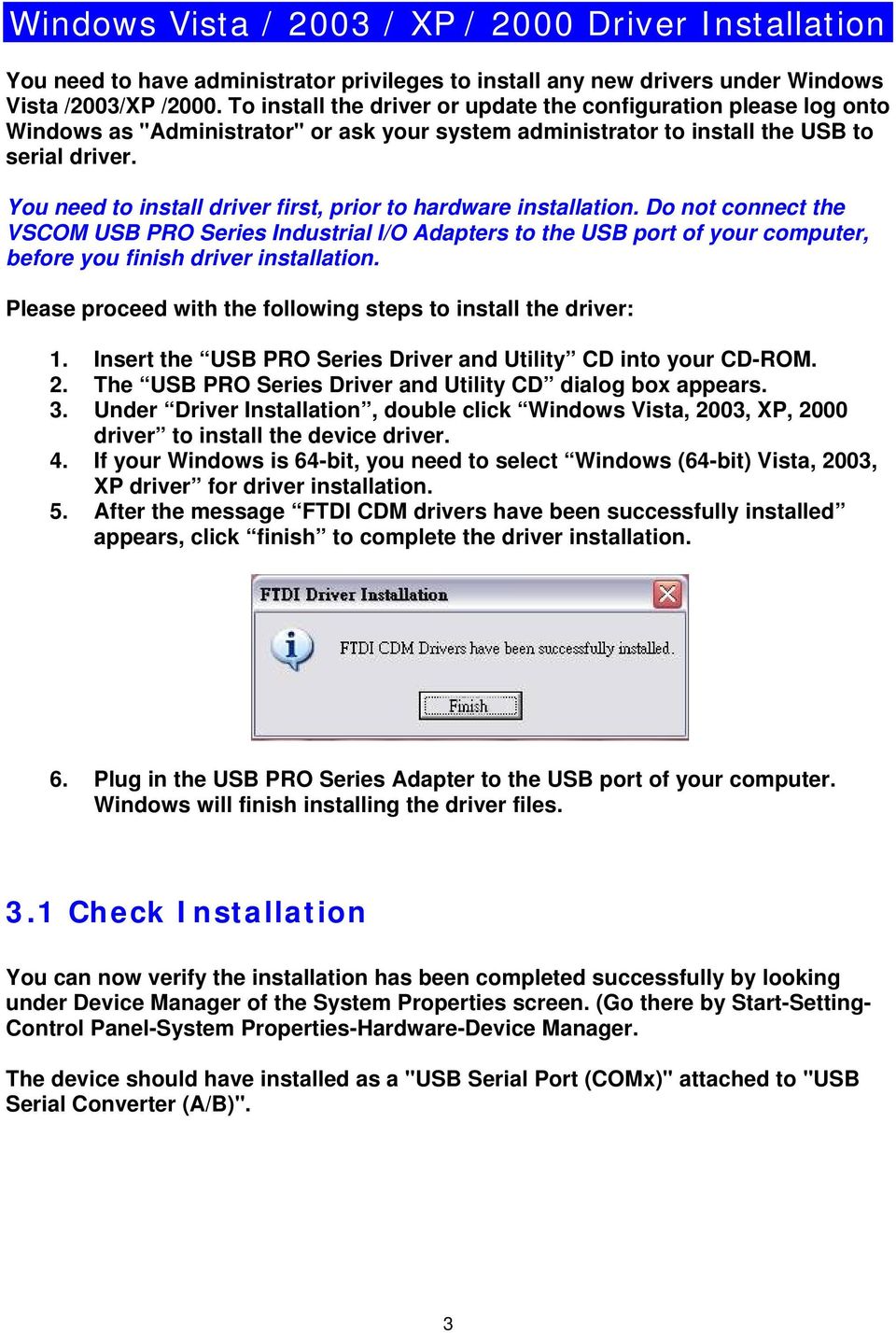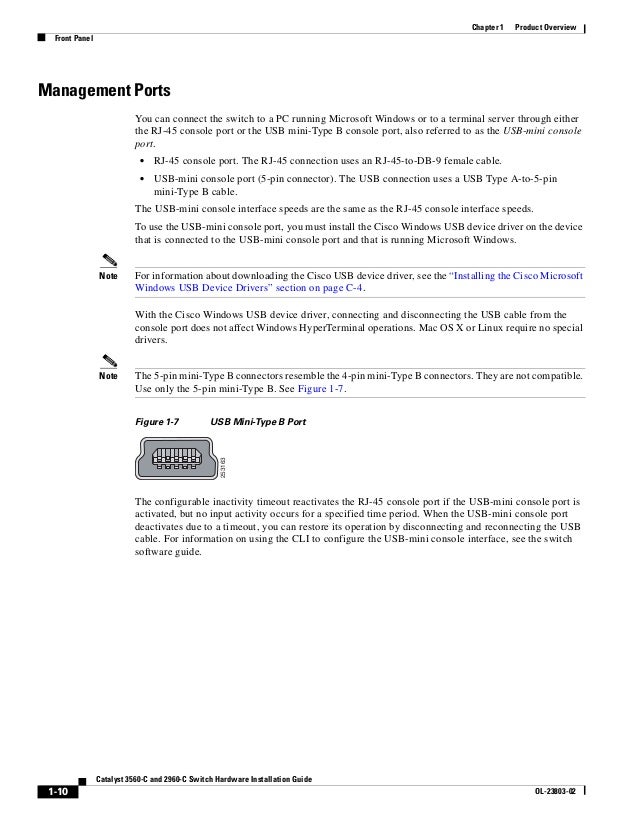Installing the Cisco Microsoft Windows USBDevice Driver
A USB function class driver implements the functionality of a specific interface (or group of interfaces) on the USB device. MTP and IpOverUsb are examples of system-supplied class drivers. The class driver may be implemented purely as a kernel-mode driver, or it may be a user-mode service paired with the system-supplied class driver. A USB device driver must be installed the first time a Microsoft Windows-based PC is connected to the USB console port on the switch. Installing the Cisco Microsoft Windows XP USB Driver. Installing the Cisco Microsoft Windows 2000 USB Driver. Installing the Cisco Microsoft Windows Vista and Windows 7 USB Driver.
Currently, Cisco has USB console drivers for the following operating systems: Windows 2000, Windows XP 32- and 64-bit, Windows Vista 32- and 64-bit Mac OS X version 10.5.4. Run the Hardware and devices troubleshooter. Try updating the latest USB devices from the manufacturer's website and check if the issue persists. Follow the steps to update the USB drivers: a. Press Windows key + X key and click Device Manager. Expand the USB driver. Right-click on the USB and click on Update driver software.
A USB devicedriver must be installed the first time a Microsoft Windows-basedPC is connected to the USB console port on the switch.
Installing the Cisco Microsoft Windows XPUSB Driver
Procedure
| Step 1 | Obtain the Cisco USB console driver file from theCisco.com web site and unzip it.
| ||
| Step 2 | If using 32-bit Windows XP, double-click the setup.exefile in the Windows_32 folder. If using 64-bit Windows XP,double-click the setup(x64).exe file in the Windows_64folder. | ||
| Step 3 | The Cisco Virtual Com InstallShield Wizardbegins. | ||
| Step 4 | The Ready to Install the Program window appears. ClickInstall. | ||
| Step 5 | The InstallShield Wizard Completed window appears.Click Finish. | ||
| Step 6 | Connect the USB cable to the PC and the switch consoleport. The USB console port LED turns green, and the Found NewHardware Wizard appears. Follow the instructions to complete thedriver installation. |
Installing The Cisco Microsoft Windows Usb Device Driver
Installing the Cisco Microsoft Windows 2000USB Driver
Procedure| Step 1 | Obtain the Cisco USB console driver file from theCisco.com web site and unzip it.
| ||
| Step 2 | Double-click the setup.exe file. | ||
| Step 3 | The Cisco Virtual Com InstallShield Wizard begins.Click Next. | ||
| Step 4 | The Ready to Install the Program window appears. ClickInstall. | ||
| Step 5 | The InstallShield Wizard Completed window appears.Click Finish. | ||
| Step 6 | Connect the USB cable to the PC and the switch consoleport. The USB console port LED turns green, and the Found NewHardware Wizard appears. Follow the instructions to complete thedriver installation. |
Installing the Cisco Microsoft WindowsVista and Windows 7 USB Driver
Procedure| Step 1 | Obtain the Cisco USB console driver file from theCisco.com web site and unzip it.
| ||
| Step 2 | If using 32-bit Windows Vista or Windows 7,double-click the setup.exe file in the Windows_32 folder. If using64-bit Windows Vista or Windows 7, double-click the setup(x64).exefile in the Windows_64 folder. | ||
| Step 3 | The Cisco Virtual Com InstallShield Wizard begins.Click Next. | ||
| Step 4 | The Ready to Install the Program window appears. ClickInstall.
| ||
| Step 5 | The InstallShield Wizard Completed window appears.Click Finish. | ||
| Step 6 | Connect the USB cable to the PC and the switch consoleport. The USB console port LED turns green, and the Found NewHardware Wizard appears. Follow the instructions to complete thedriver installation. |
Uninstalling the Cisco Microsoft WindowsUSB Driver

Uninstalling the Cisco Microsoft Windows XPand 2000 USB Driver

Use theWindows Add or Remove Programs utility or the setup.exe file.
Using the Setup.exe Program
Before You BeginDisconnect the switch console terminal beforeuninstalling the driver.
Procedure| Step 1 | Runsetup.exe for Windows 32-bit or setup(x64).exe for Windows-64bit.Click Next. |
| Step 2 | TheInstallShield Wizard for Cisco Virtual Com appears. ClickNext. |
| Step 3 | When theProgram Maintenance window appears, select the Remove radio button.Click Next. |
| Step 4 | When theRemove the Program window appears, clickRemove. |
| Step 5 | When theInstallShield Wizard Completed window appears, clickFinish. |
Using the Add or Remove ProgramsUtility
Before You BeginDisconnect the switch console terminal beforeuninstalling the driver.
Procedure| Step 1 | ClickStart > Control Panel >Add or Remove Programs. |
| Step 2 | Scrollto Cisco Virtual Com and click Remove. |
| Step 3 | When theProgram Maintenance window appears, select theRemove radio button. ClickNext. |
Uninstalling the Cisco Microsoft WindowsVista and Windows 7 USB Driver
 Before You Begin
Before You BeginDisconnectthe switch console terminal before uninstalling the driver.
Procedure| Step 1 | Run setup.exe for Windows 32-bit or setup(x64).exe forWindows-64bit. Click Next. | ||
| Step 2 | The InstallShield Wizard for Cisco Virtual Com appears.Click Next. | ||
| Step 3 | When the Program Maintenance window appears, select theRemove radio button. Click Next. | ||
| Step 4 | When the Remove the Program window appears, clickRemove.
| ||
| Step 5 | When the InstallShield Wizard Completed window appears,click Finish. |
This topics in this section describe the class drivers, generic client driver, and the parent composite driver that are provided by Microsoft.
Microsoft-provided USB drivers for controllers and hubs
Microsoft provides these set of drivers:
- For USB host controllers and hubs. For more information, see USB host-side drivers in Windows. You can develop a custom host controller driver that communicates with the USB host controller extension (UCX) driver. For more information, see Developing Windows drivers for USB host controllers.
- For handling common function logic for USB devices. For more information, see USB device-side drivers in Windows.
- For supporting Type-C connectors. For more information, see USB connector manager class extension (UcmCx).
Cisco Microsoft Windows Usb Device Driver
Other Microsoft-provided USB drivers
| Device setup class | Microsoft-provided driver and INF | Windows support | Description |
|---|---|---|---|
| USB | Usbccgp.sys Usb.inf | Windows 8.1 Windows 8 Windows 7 Windows Vista Windows XP | Usbccgp.sys is a parent driver for composite devices that supports multiple functions. For more information, see USB Generic Parent Driver (Usbccgp.sys). |
| Biometric | WudfUsbBID.dll WudfUsbBIDAdvanced.inf | Windows 8.1 Windows 8 | Microsoft supports USB biometric devices (fingerprint readers) by providing the Windows Biometric Framework. See the Windows Biometric Framework. |
| Media Transfer Protocol Devices | Wpdusb.sys (Obsolete) | Windows Server 2008 Windows Vista Windows Server 2003 Windows XP | Note Starting in Windows 7, Microsoft has replaced the kernel mode component of the Windows Vista USB driver stack (Wpdusb.sys) for Windows Portable Devices (WPD) with the generic Winusb.sys. Microsoft provides the Wpdusb.sys driver to manage portable devices that support the Media Transfer Protocol. See WPD Design Guide. |
| USBDevice | Winusb.sys Winusb.inf | Windows 8.1 Windows 8 Windows 7 Windows Vista Windows XP with Service Pack 2 (SP2) | Winusb.sys can be used as the USB device's function driver instead of implementing a driver. See WinUSB. |
Microsoft-provided USB device class drivers

Microsoft provides drivers for several USB device classes approved by USB-IF. These drivers and their installation files are included in Windows. They are available in the WindowsSystem32DriverStoreFileRepository folder.
See, USB device class drivers included in Windows.
Related topics
Universal Serial Bus (USB)
USB Driver Development Guide